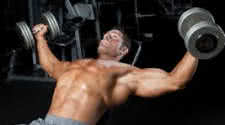Low Incline Flys - Build a Broad & Brawny Upper Torso

Never Use the Same Exercise Day after Day
Adding more muscle size to the chest is a quest that many undertake. Building more muscle mass into the chest really improves the appearance of the upper body and even affects the
appearance of your midsection. How? Think about it. The wider your chest is, the trimmer your waist and hips appear in comparison. The more depth you have in your chest, the thinner
your waist and buttocks look when viewed from the side. Besides these factors a broad, deep chest simply looks great and sets the tone for the full upper torso in any competition.
Off the platform it is just as impressive-whether in a summer T-shirt or a winter turtleneck.
There are many reasons for adding new muscle size to the chest. Similarly there are also dozens of approaches for training to achieve this goal. Some focus on more bench presses;
others crank up the weight on the newer chest machines. One exercise that can get overlooked is the low-incline five, a superb movement for adding both width and depth to the chest
area.
SPECIALIZED FLYS
A lot of people use the dumbbell fly, which hits the central/lower/outer area of the chest muscles. By adjusting the angle of the exercise slightly, you can refocus the workload onto the upper chest. This specialized fly impacts your chest a bit differently from regular flys. A slight incline will hit the upper/outer area of the chest hard. Working an exercise from a new angle is a good stimulus for new growth. One important caveat needs to be noted: Don't increase the angle too much. Make the angle of the incline too high and you shift the emphasis off the upper chest and onto the front of the shoulders. Other muscle groups join in as well when the angle is too high - exactly what you don't want.The aim of using the low-incline fly is to keep the chest isolated, particularly the upper and outer areas. The best way to do this is with the low incline. The incline angle that works best for many is about halfway between the angle of the standard incline bench and the flat bench. An angle of 15 to 30 degrees is ideal although most incline benches are angled at 45 degrees or steeper. Fortunately some standard incline benches can be adjusted to a lower angle. Another option is to put a steady prop under a regular bench to angle it up slightly, or to use a decline bench backward. Whatever adjustments you make, aim at an angle of 15 to 30 degrees.
The angle of the bench is important. So is the angle of your fly motion. Instead of the standard movement of the flat fly, angle your motion just a little upward over the upper end of your chest as you raise the dumbbells. Turn your thumbs slightly in toward each other to bring the upper region of the chest fully into play. By making these adjustments you can stimulate your chest strongly.
SLOW & HEAVY
You should do the low-incline fly slowly. While stretching your upper chest, you don't want to tear anything. A slow motion helps you to focus on the upper and outer chest and enables you to make certain you are bringing the dumbbells up high (above the neck/chin region) and twisting the wrists in at the top. It also eliminates the possibility of momentum taking the workload off the chest. Going slowly will let you "feel" your upper and outer chest work and make slight adjustments to keep these muscles under tension.Start with light weights to get the feel of the exercise and prevent injury as you put your physique into a new stretched-out position. Over the course of several weeks increase the weight in small increments when you can complete 10 tough repetitions. Slowly work up until you are able to handle heavy-duty weights.
If you are looking for a new way to spark growth in your chest, start using the low-incline fly. Consistent use of this dynamite exercise will add a nice new layer of size to your upper/outer chest.